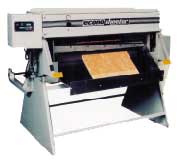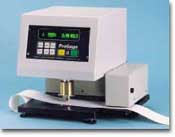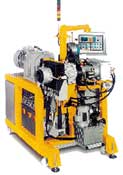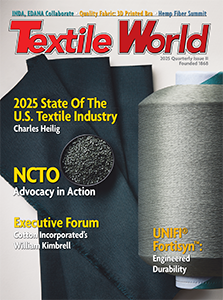Otto Zollinger Inc., Spartanburg, S.C., offers the Oz® Quickset yarn tension control and the
Oz-2000Q yarn tension control for tufting creels.The Quickset features quick and easy tension
adjustments if necessary for running differently sized yarn. There are no spare parts, and no
cleaning is required.The Oz-2000Q may be threaded from top or bottom and has only one opening per
side. It is easily mounted to the existing creel.
2000
Two New Developments In Controlling Yarn Tension
High-Performance Tricot Machine Offers Flexibility

Germany-based Karl Mayer offers the high-performance tricot machine HKS 3 M. The three-bar
unit operates with medium-stroke needles and is equipped with the new EBA 2-Step System. The
machine is ideal for the production of garments, house and home textiles, and various
semi-technical articles including special constructions and elastic fabrics with elastane portion.
2000
System Solutions By ESI
System Solutions By ESI
Report on a systems integrator for textile finishing, nonwovens and the carpet
industry.Electrical Systems Inc. (ESI) established its roots 30 years ago. Back then, it was
conventional armature motors that the companys fathers rebuilt or replaced with better technology.
Today, ESI is a high-tech systems provider for applications in the textile industry and other
industries. For textile applications, the company concentrates on finishing, nonwovens and carpet
manufacturing. The company headquarters is located in Chattanooga, Tenn., and the company has a
service facility in Greenville, S.C.At the beginning of this year, ESI was acquired by the NSC
Group (N. Schlumberger Inc., France), which, according to company executives, will give the company
financial strength for growth and expansion into new areas, particularly the plastics, film and
paper converting industries.Mike Mauney, ESIs director of sales, emphasized the acquisition will
not affect the companys confidential cooperation with NSC competitors machinery manufacturers with
which large projects were already underway at the time of the merger. We would be a dead duck if we
abused the confidentiality agreements, Mauney said. ESI gets a wide range of customer orders
because of its reputation for understanding the manufacturing processes, and the companys worldwide
service commitment.Project Management PhilosophyESIs philosophy is to implement standardized
project management procedures for every project, regardless of its size, to ensure 100-percent
customer satisfaction. The following outlines some of ESIs key project-management procedures:
- assignment of a project engineer to supervise the project from design to start-up;
- charted project organization to determine bottlenecks and to minimize timing problems for
delivery; - regular project status updates and meetings;
- witness testing of systems prior to shipment;
- professional field staff start-up;
- complete engineering drawings for the system as installed;
- operator training; and
- spare parts recommendations.
ESI has grown and diversified over the years into different fields and kept up with the
advancements of the latest drive and systems control technology. The company has made it its task
not just to provide a system, but rather to evaluate the actual situation in a plant and to provide
the best possible and most economical solution for its customers. A team of highly specialized
engineers identifies and evaluates all control strategy options by analyzing the application and by
consulting with customer personnel. ESI calls this a one-on-one service for clients. Personal
contact is maintained with every client throughout the entire project. Because of this, ESI says it
has improved the overall performance of many customer mill, machine efficiency and product
quality.Modern Drive Technology: Latest Systems AppliedNo matter what drive technology is used on
older or new machinery, ESI offers system solutions to better control the manufacturing process.
With older drives, it is often much more economical to replace the conventional motors with AC or
DC drive technology. A cost calculation with return on investment (ROI) can clearly show what
modern drive technology can save on maintenance and service cost when compared to earlier
technology. At the same time, product quality improvements, better supervision and feedback from
the process are possible. Therefore, ESI has been a leader for many years in the integration of
drives and drive-oriented systems that include AC and DC drive systems, as well as stand-alone PLC
and automation systems. Lately the PC-based control systems have been in great demand because,
compared to PLC systems, they are low cost, flexible and offer quick serviceability. PC systems are
also much easier to expand than PLC based systems. ESI pointed out that the PC-based systems are
still not the solution for every application, but since the introduction of the Windows NT
operating software, the reliability of PC-based systems has improved significantly. In case of a
fatal hardware failure, it may be as easy as replacing the failed hardware and reloading the
software to get the system up and running again.Mauney emphasized that ESI is not strictly aligned
with only one electrical component manufacturer. The company enjoys an excellent relationship with
the worlds leading manufacturers of high-tech system solutions such as ABB, Magnetek, Reliance,
Rockwell Automation, Siemens, Toshiba, and many others. This gives ESIs engineers the freedom to
use the best from the best in the design phase for specific customer applications.Nonwovens, Carpet
And Finishing ApplicationsESI named a number of applications for which the company has installed
drive and control systems.The nonwovens field is an ever- growing market segment for ESI. Even
though ESI is owned by Schlumberger, which is also one of its largest clients, the company has
executed many projects that incorporate the Dilo Group, Fehrer and other suppliers that are
competitors to Schlumberger. At the end, what counts is that ESIs customer, the actual nonwovens
plant, needs to be satisfied with the specific control setup. And so far, the company has received
a lot of praise and repeat business.Besides nonwovens, which has typically been a dynamic industry,
the carpet manufacturing industry has seen many changes over the past few years. ESI has helped
these companies to stay productive through custom integration of sophisticated drive and control
systems. The company provides motor/reducer combinations selected for optimum efficiency and
durability. Further, ESI provides web-sensing devices and load cells to interface with process
lines. For every application, the options range from simple armature, voltage-controlled DC drives
to fully integrated systems with multiple PC-based MMI systems and state-of-the-art AV vector
drives incorporated in custom enclosures.Also important to ESI are finishing applications for
warpers, slashers, preparation ranges, mercerizers, tenter ranges, conventional dye ranges, indigo
dye ranges, and sanforizers.Other growing fields of activities for ESI include the plastics and
film industries and the paper converting industry. Especially in the plastics and film, the capital
investment is very high and, therefore, requires efficient, smooth-running processing machinery.The
Electrical Systems Inc. AdvantageIn summary, ESI emphasizes that for a customer they are the single
source of responsibility that tailors equipment and services specifically to each customers needs.
Usually, this permits a more efficient system layout with lower investment cost. All equipment and
services come from domestic suppliers, which reflects in lower maintenance cost. As well, the
company offers seven-day, 24-hour service for its customers.
November 2000
DSM Shell Develop Novel Caprolactam Route
DSM Research and Shell Chemi-cals, both based in The Netherlands, are jointly working on a
DSM-sponsored project aimed at the development of a novel caprolactam route based on butadiene.
Caprolactam is the basic starting material for nylon 6.Current technology for the manufacture of
caprolactam is based on either cyclohexane or phenol. Novel investments based on these routes are
uneconomical because large quantities of am-monium sulphate are produced.DSM is committed to
caprolactam, said Dick J. Venderbos, business group director, DSM Fiber Inter-mediates. This
process, called DSM ALTAM, is based on butadiene and carbon monoxide and would further increase the
competitive position of caprolactam and nylon 6 versus other materials.
November 2000
New Denim With Cordura Available From Glen Raven
Glen Raven Filament Fabrics LLC, Burnsville, N.C., has introduced a new denim using DuPont Cordura®
nylon to offer added strength, durability and colorfastness while maintaining the look and feel of
cotton.Because the fabric combines softness with strength, the new denim made with Cordura is
well-suited to a variety of end-uses, from school uniforms to career apparel to contract
upholstery, said Gary Zumstein, vice president, sales.The new denims densely woven construction
combines Cordura high-tenacity nylon with co-textured microdenier nylon/polyester. The microdenier
yarns add softness and create a range of possibilities for design and color.
November 2000
Unifi And Sans Fibres Announce Joint Venture
Unifi Inc., Greensboro, N.C., and South Africa-based Sans Fibres announced that the two companies
will form a joint venture to produce low-shrinkage, high-tenacity nylon 66 light-denier industrial
(LDI) yarns. Unifi-Sans Technical Fibers LLC will be the the new name for the venture.A nylon
spinning and draw-twisting operation will be installed in Unifis Madison, N.C., facility. Unifi
will manage the day-to-day production and shipping of the LDI yarn, and Sans Fibres will handle the
technical support and sales.Unifi-Sans Technical Fibers will also incorporate the two-stage LDI
nylon yarn business of Solutia Inc., which is being purchased by Sans Fibres. Production will be
transitioned from Solutias Greenwood, S.C., site to the Unifi-Sans Technical Fibers facility over
the next two years.
November 2000
Cargill Dow Awarded Grant For Bio-based Chemicals R And D
The U.S. Department of Energy (DOE) has awarded more than $2 million to Cargill Dow, Minnetonka,
Minn., for continued research and development of the companys fermentation process for utilizing
annually renewable resources.The DOE administers two financial assistance programs in support of
President Bill Clintons executive order to triple U.S. use of biobased products and bioenergy by
2010. Cargill Dow will share equally with the DOE the $4.6 million budget for the projects.The
projects center on developing process technology for the fermentation of corn fiber and corn stover
to lactic acid and a number of other products. The results will help support the continued
advancement of Cargill Dows NatureWorks PLA, which is derived entirely from annually renewable
resources, as well as help develop other biobased products. Ultimately, Cargill Dows
fermentation-based manufacturing technology will be able to be used anywhere in the world, using
native agricultural by-products.NatureWorks PLA has applications in both fibers and packaging
markets (See K/A News, ATI, this issue). In packaging, potential end-uses include high-value films,
rigid thermoformed food and beverage containers, and coated papers and boards. New, emerging
applications such as injection-, stretch- and blow-molded bottles are also being explored.
November 2000
Thickness Tester Provides Quick Easy Measuring

Philadelphia-based Thwing-Albert Instrument Co. has developed the ProGage, a new micrometer
that measures thickness to most testing standards. The anvil and dual-speed pressure foot with
high-speed return increases the samples measured per minute while maintaining a high degree of
accuracy. An optional auto-feed provides continuous sample profiling and minimizes operator
interface. Enhanced graphics and database capabilities are also available.
2000
Rubbex System From Maag Pump Systems Textron

Switzerland-based Maag Pump Systems Textron Inc., has introduced rubbex®, a complete system
for processing almost all natural and synthetic elastomers. The rubbex unit is a combination of a
gear pump, feed unit, filter and universal die. A screen changer is also available as an option.
The design of the system makes it possible to combine straining and forming processes into a single
step, allowing for the production of semi-finished products. This unit allows for gentle processing
of the elastomers at the lowest processing temperatures.The system is offered in five sizes for
throughputs ranging from 50 to 3,600 kilograms per hour and is almost entirely self-cleaning.
2000
Wayn-Tex Colbond Develop Stabilok Primary Backing
Stabilok, a combination of woven and nonwoven primary carpet backing, has been created through a
partnership between Wayn-Tex Inc., Dalton, Ga., and Colbond Nonwovens, Enka, N.C. The backing was
designed to eliminate the potential bowing and skewing that occasionally develops during the
tufting, dyeing and finishing process.The requirement for a stable, almost bow- and skew-proof
primary backing was evident when standard backings werent able to consistently meet the challenges
of patterned tufted carpets, said Durwood Knight, vice president, sales and marketing, Wayn-Tex
Inc. The two companies hope the alignment of resources and combination of products is solving an
expensive problem for the industry.
November 2000




